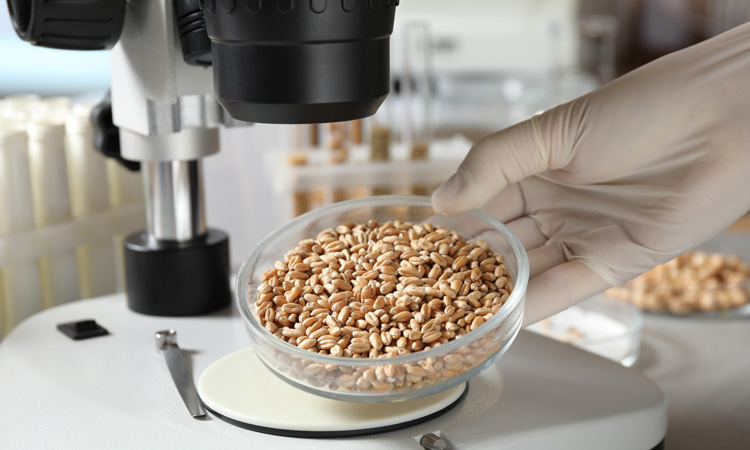Sampling for mycotoxins in grain
- Like
- Digg
- Del
- Tumblr
- VKontakte
- Buffer
- Love This
- Odnoklassniki
- Meneame
- Blogger
- Amazon
- Yahoo Mail
- Gmail
- AOL
- Newsvine
- HackerNews
- Evernote
- MySpace
- Mail.ru
- Viadeo
- Line
- Comments
- Yummly
- SMS
- Viber
- Telegram
- Subscribe
- Skype
- Facebook Messenger
- Kakao
- LiveJournal
- Yammer
- Edgar
- Fintel
- Mix
- Instapaper
- Copy Link
Posted: 2 December 2019 | Kerri Pleskach | No comments yet
Improper sampling can lead to a variability in mycotoxin analysis, decreasing the accuracy and precision. Here, Kerri Pleskach from the Grain Research Laboratory at the Canadian Grain Commission explains how well thought out sampling procedures can mitigate the issue.


In the world of mycotoxins, sampling is one of the most important aspects of analysis and can be the biggest source of variance within results. Mycotoxins are heterogeneously distributed in grain and therefore improper sampling can lead to data that is an under- or over-estimation of the mean concentration within the grain.
Improper sampling can also lead to an increase in the variability of replicate mycotoxin analysis, decreasing the accuracy and precision. This is important when management decisions are to be made from analysis, and when two different laboratories present two different mycotoxin results, which one is the “correct” value?
Improper sampling can also lead to an increase in the variability of replicate mycotoxin analysis, decreasing the accuracy and precision
Ochratoxin A (OTA)
For example, ochratoxin A (OTA) is a mycotoxin that is produced primarily on cereals while in storage in temperate climates. This creates pockets of OTA in the grain, and along with each pocket, each individual grain kernel can have vastly different concentrations of OTA.
Our group conducted a study on OTA in Penicillium verrucosum-infected grain, which showed that over a 10-week storage period, kernels with measurable OTA could range from 30-20,030 ppb on individual kernels. The Codex Alimentarius Commission has set a maximum limit of 5 mg/kg for OTA in wheat, durum, barley and oats. At this this maximum level, a few contaminated kernels in a one kg sub-sample can make a significant difference in the final concentration.
One can imagine with improper sampling techniques, the sub-sample used for laboratory analysis could have a concentration of OTA that is vastly different from the actual concentration of OTA from the bulk sample that is contained in the storage unit. Before sub-sampling any quantity of grain, one needs to develop a sampling plan. Considerations of the quantity of grain being sampled, the proper equipment to use for sampling, the mass of the test portion needed for mycotoxin analysis, and how many increments to take are all key aspects of a quality sampling plan.
Preventing sampling bias
In the Grain Safety unit at the Canadian Grain Commission, any sampling that we do is always well planned out before the project starts. We also use specialised equipment that is made specifically for sampling that we evaluate based on how it performs and make evidence-based decisions on the equipment that we select. We use rotor beater mills to comminute the sample to reduce the particle size of the grain, which in turn reduces the variance and bias of each sub-sample.
The sample then needs to be mixed to increase the homogeneity of the sample. Mixing a sample by stirring or shaking does not work when the sample is a mixture of particle sizes and densities as layers are formed with lighter particles rising to the top and heavier particles sinking to the bottom, which could lead to sampling bias. We mix by passing our ground grain through a rotary sample divider at least twice; once to mix the sample completely and the second time to divide the sample into the test portion size that is required for analysis.
A well thought out sampling plan and the use of correct sampling equipment are key aspects to quality mycotoxin data
The sample is automatically sampled while moving along a vibratory feeder, which allows an equi-probable chance of all particles of the sample to be selected. All divisions are done at a minimum of 100 rotations a minute, which results in at least 100 increments of sample taken per minute for each sub-sample. Using the rotary sample divider, this increases the accuracy and precision of mycotoxin analysis within each sub-sample.
A well thought out sampling plan and the use of correct sampling equipment are key aspects to quality mycotoxin data. Without proper sampling, the sub-sample taken for laboratory analysis will not be representative of the bulk grain sample that the sub-sample was taken from, therefore producing data that may not be meaningful, preventing appropriate management decisions.
About the author
Kerri Pleskach is the team lead for they mycotoxin group in the Grain Research Laboratory at the Canadian Grain Commission. In this role, she supervises the work on sample preparation including grinding and dividing and mycotoxin analysis by mass spectrometry. Kerri’s training and experience over the last 16 years has given her the expertise to prepare grain for mycotoxin analysis as well as the analyses themselves.
Related topics
Food Safety, Mycotoxins, Quality analysis & quality control (QA/QC), Regulation & Legislation, Research & development








